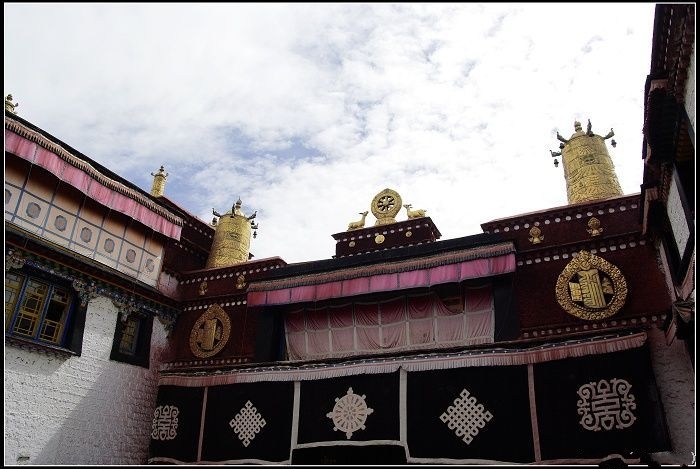Situated in the center of the old city of Lhasa, Jokhang Temple is the first Buddhist temple in Tibet. It is also the Sacred Temple of all Tibetan Buddhists. All year-round many Tibetan Buddhists go on a pilgrimage to Lhasa, from all over Tibet and other provinces like Qinghai, Gansu and Inner Mongolia, and their destination is the Jokhang Temple.
In the middle of the seventh century, the great Tibetan King of the Tubo Kingdom, Songtsen Gampo (617- 650 AD) married the Nepalese Princess Tritsun and the Chinese Princess Wencheng, each of whom brought into Tibet a statue of Sakyamuni.
At that time there were very few buildings and people were living in tents, to say nothing of palaces. In order to enshrine and worship these two invaluable statues, Princess Wencheng suggested that they build two temples. According to the legend, several floods occurred during the process of the construction. Princess Wencheng explained that the Qinghai-Tibet Plateau was a lying Raksasi, and the lake, where they were going to build the Jokhang Temple was her heart and the lake water was her blood.
To strengthen the throne of the Tubo Kingdom, they must construct the temple over the lake so that they could suppress the Raksasi and unite the kingdom. White goats were used to carry sand and earth to fill in the lake. To commemorate the great work of the goats, the Jokhang Temple was first named Rasa, which in Tibetan means 'goats carry the earth'. When you visit the temple, you will find a statue of a small goat in one hall, which is coated with gold and is still worshiped as a divine goat today.


The Ramoche Monastery was built to consecrate the life-sized statue of the twelve year-old Sakyamuni and the Jokhang Temple to consecrate the life-sized statue of the eight year-old Sakyamuni. In 710 AD, Chinese Princess Jincheng married another King of Tubo and swapped the location of the two statues; today the statue of the of twelve year-old Sakyamuni is in the Jokhang Temple and the statue of eight year-old Sakyamuni is in the Ramoche Monastery.
It is said that there are only three life-sized statues of Sakyamuni in the world that were all molded according to the appearance of Sakyamuni at the ages of eight, twelve and twenty-five, all the three statues were consecrated in India at the beginning. The statue of eight-year-old Sakyamuni, which the Princess Tritsun brought to Lhasa, was damaged and is not in its full integrity today. The statue of twenty-five-year-old Sakyamuni was lost. The statue of twelve-year-old Sakyamuni is the most exquisite of the three. The Princess Wencheng spent three years bringing the statue from Chang'an to Lhasa. The statue is incomparable in honor. The Tibetan Buddhists trek a long way from their homes to Lhasa to worship this statue, not for the statue's great value as a culture relic but rather that they strongly believe that the statue is exactly the same appearance as Sakyamuni 2500 years ago. This is their opportunity to have a look at a real divinity. Lhasa is in part regarded as a sacred city because of this sacred statue.
Jokhang Temple is not subordinate to any Buddhist sects, and is always the place in Tibet where major Buddhist ceremonies are held. When the Ganden Podrang regime was established by the fifth Dalai Lama, his government offices were set up in this temple. The Initiation Ceremonies of the Dalai Lama and the Panchen Lama were held in this temple and each year the Great Prayer Festival is held here as well.









